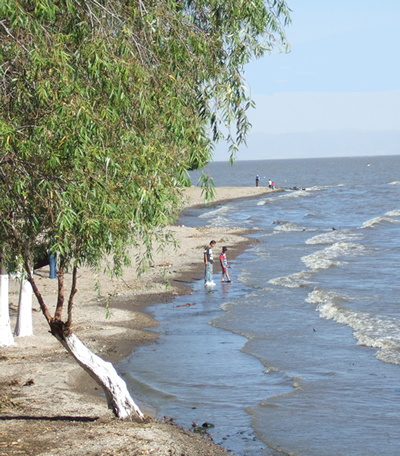| This is our fourth and last month of our visit to Mexico and with each month we have enjoyed our time here more than the last. The greatest news for us is that Lake Chapala is cleaner than most of us thought. In fact, it is cleaner than most of the beaches along the California coast and as a result major initiatives are being undertaken to improve the beaches for swimming and boating. As you will see as you peruse these snapshots, they include a "vacation" to different parts of Mexico, Easter celebrations, Glorine's surprise birthday party and much more.
We will be leaving Ajijic on March 26, with a side trip on a train through Copper Canyon (Mexico's Grand Canyon). We will be crossing the border in early April with stops in Tucson, Phoenix, and Parker, AZ and Fullerton, CA to see family and friends. We will be home by April 15. From there our "Roaming through Retirement" continues!!
We are so appreciative of the many emails we have gotten. It is always nice to stay in touch. Click here to send us an email Larry and Glorine.
|





|
 |
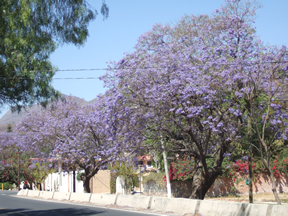 |
| In March, a study on the condition of the lake was release and to most peoples surprise the results were remarkable. Once considered nearly a dead lake, 17 of the 19 areas tested along the north and west sides of the lake (which is where Ajijic and where most of the Americans and Canadians live) were nearly one-half of the acceptable standard for bacteria. And with this news, the politicians and civic leader embarked on the major campaign to do a major face lift to the lake to make it even more attractive for tourist and residents. |
Spring arrived!! While it has been in the 70s and 80s during our entire stay and many trees and shrubs were in full bloom, many others naturally went dormant and as this picture depicts, the whole area is moving toward full bloom. April and May are considered the hot months with temperatures in the 90s. From June to September it rains nearly everyday, which brings the temperatures down to the 70s and 80s again. We are told the rain comes late afternoons and at night, so most days remain pleasant and the mountains turn green like a head of broccoli. |
| |
|
| We took a one week vacation to the high country of Central Mexico. Our first stop was the El Rosario Monarch Sanctuary, the wintering home for the Monarch butterflies. We stayed at a beautiful B&B, which included a tour of one of the five sanctuaries set aside to protect the butterflies. It included a guided tour up to the butterflies, first by car, then by horseback and lastly on foot. |
Incredible and indescribable are the two words that defined this experience. Some of the evergreen trees were so thick with butterflies that you could not see the green. While the terrain was extremely rugged, our guides made sure we arrived back off the mountain safe. We are still awe stroke by the experience. |
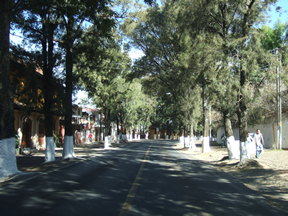 |
|
| The next two nights we spent in Patzcuaro (pronounced pot-squaw-row). It is said to be "the loveliest town in Mexico". We stayed at another B&B and had breakfast both mornings with people from Ajijic. Walking through the churches and plazas is where we spent much of our time. |
Lake Patzcuaro, sitting at 7,216 foot elevation, has several islands. Janitzio, the largest island, is known for a large celebration for The Day of the Dead, which is on November 1st and 2nd. Catrinas, are one of the most popular figures used during the Day of the Dead celebrations. The other noteworthy thing about Patzcuaro is its handcrafted wood carvings--fantastic sculptures of full life-size wooden saints to complete sets of furniture. |
| |
|
| One of our side trips was to Santa Clara Del Cobre, known for its copper smithery. We took a tour of one of the shops where they smelted the cooper, handcrafted them (hammering this sink shaped from a flat sheet of copper),and hand painted them. Lastly we shopped in the store in front of the workshop. Beautiful handcrafted items for very little money. |
On our drive back to Patzcuaro, we drove through Zirahuena (pronounced zeer-ah-you-ay-nah) which has the most beautiful blue lake we have seen in Mexico. We took a cruise in an enclosed boat to resorts along the shore line. One area is said to be 600 feet deep. |
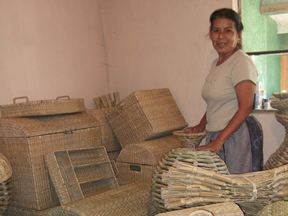 |
|
| As we left Patzcuaro, we stopped at a lake side village called Ihuatzio (ee-you-aht-zeeo) which is known for its weaving of reeds that grow on the edge of the lake. Here is a room full of various weaved items stored in the living room of one of the Mexicans we met. We bought several small baskets for presents. Click to enlarge. |
Ihuatzio is also the sight of one of hundreds of Mexican archaeological ruins that date back 2000 years. Two of the village children escorted us about a mile north of town to tour these ruins. |
| |
|
| We spent the next four days exploring the colonial city of Guanajuato (pronounce gwah-nah-whah-toe) which looked and felt more like a city in France, Spain or Italy than in Mexico. It was build as a silver mining community in 1559 and sits in a highland valley at 6,500 foot elevation. Guanajuato was at the heart of the Mexican Revolution started in 1910. Many of the statues depict the heroes that struggled against Spain much as our fore fathers struggled again England. As was the case throughout Mexico, the Catholic Church was a major force in Guanajuato and as you will see, they dot the landscape of this beautiful city. This church is having a major face lift with artisans repairing every aspect of the church that makes it so breadth taking. |
Initially, we were planning on touring this region with two friends from Ajijic, Norm and Erma. However, we decided our schedules were getting too convoluted so we went alone. After we checked into our hotel, we took a stroll around the downtown area and who did we run into--Norm and Erma. So we spent the next two days touring the city together. The streets and alley ways run every which way--so much so that one could get lost. But this is what makes Guanajuato so photogenic. We must have taken over 100 photos and none really do the beauty of this city any justice. Right outside our hotel was the main plaza, which was good and bad. It had some mighty fine restaurants, but the night life could be heard to the wee hours of the morning. |
| |
|
| Because Guanajuato was one of the world's largest silver mining towns, there were more than 150 haciendas for the wealthy mine owners. While most lie in ruin, some have been restored. We spent several hours going through one that was restored as a museum--Museo Exhacienda San Gabriel de Barrera. Along with luxurious accommodations for the family of the mine owner, they had their own chapel and magnificent gardens. |
After a hard day of touring, we participated in the great night life. Musicians seemed to be everywhere and the food was great. Another unique aspect of Guanajuato was a significant network of tunnels that snaked around the underside of the city. When we first arrived, we took the road marked "city centro" and got into this tunnel that had to be more than a mile long. Parking was very limited, so some of the one-way tunnels have room for parking. |
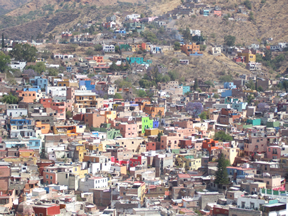 |
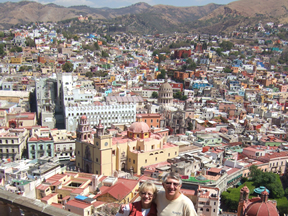 |
| Another thing that makes this city so unique is the color. From the brightest yellows to wildest pinks and greens, every home has its own character. Here we are near one of the statues and taking in the spectacular view of this city. Click to enlarge. |
In another direction, we had this picture taken of us, with the University of Guanajuato (which has 10 campuses spread out throughout the city and attracts students from throughout the world) along with several churches and colorful homes stretching up to the foot hills. Click to enlarge. |
| |
|
| Dolores Hidalgo is the name of a historic city about 25 miles northwest of Guanajuato. It was at this point that "Father Hidalgo proclaimed the independence of Mexico." A statue of Hidalgo stands in the plaza next to the Church he preached in. It is truly a beautiful Church filled with ornate sculptures, painting, etc. |
Dolores is also known for its Talavera pottery, which we bought a lot of. We stopped at San Gabriel, a pottery shop and saw each step in the process from dry clay, to the empty forms, to the forms filled with the clay, to the finishing work and finally the artisans painting. It was a treat! |
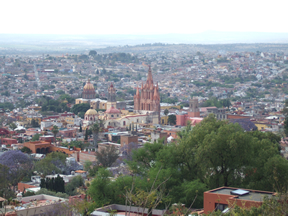 |
 |
| From Dolores, we drove to San Miguel de Allende, a town of about 130,000. Steeped in the revolution was San Miguel's son Ignacio who was one of the four historic leaders to make the revolution a reality. It is a very affluent city and because of its great access to Mexico City and Guadalajara is a favorite vacation spot for Mexicans and foreigners alike. We only spent a couple of hours there, but not before buying three pairs of the "now famous" San Miguel sandals. Click to enlarge. |
We returned to Ajijic just in time for a host of going away parties, as many snow birds leave before the first of April. Here Chuck and Jeanne (friends from Oakland, CA) hosted a pot luck for about 30 guests. We knew about half of the people there and got to meet many more people who make Ajijic their year around home. "Mi Casa Su Casa" is an often heard phrase here in Mexico. It means "my home is your home." Another great treat. |
| |
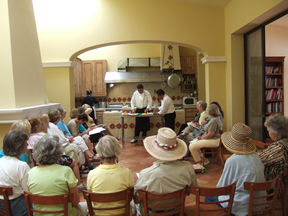 |
| In February, we mentioned Glorine's involvement with an Organic Farm (known simple as ACA) near Ajijic and a weekly lecture series that focuses on organically grown foods. Here we are at the "abastos market" in Guadalajara, one of the largest retail and wholesale food outlet in Mexico. It covers seven blocks by four blocks. Here is Glorine with Wendy (one of the owners of ACA) with about 40 people from Ajijic who took a bus tour to see this gigantic market, along with a couple of snapshots of one of the many buildings and one of the smaller vendors. |
Another lecture was a trip to Manuel's Restaurant in Ajijic. Here about 25 people gather to watch an organic food demonstration. Manuel was the Executive Chef for ARAMARK (a major food service provider to 1,000's of universities, hospitals, stadiums and arenas around the world). In fact, Boise State contracted with Aramark to run their food service. About two years ago, he gave up the corporate world to move back home to Mexico. After a two hour demonstration, we were treated to a four course meal that "was to die for." |
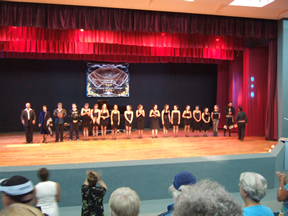 |
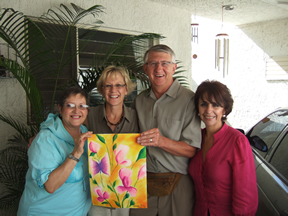 |
| A night at the THEATER! With all of the expatriate Canadians and Americans, a lot of talent is sought and drawn to Ajijic. This ranges from paintings, photography, weaving, writing, music, etc. Here we are attending "The Tango" a musical group from Argentina. Click to play a video and sit back and enjoy another special evening in Ajijic. |
About two months ago, we went to our traditional Wednesday evening happy hour called Los Amigos (The Friends) and sat next to these two women. Glorine said "Los Amigos" and they said "Si". Within a few minutes, several other Americans and Canadians joined our table. Later we found out that Teresita Hermosillo Buzali (Tere) and Yvonne Ruth Loza Becerra were down from Guadalajara relaxing for a few days. As the evening progressed, we asked them to join us for an evening of dinner and dancing and they did. Since then, we have communicated and enjoyed each others company. Here we are in Guadalajara to say farewell to our new found friends. This painting was a going away gift from Yvonne. Tere gave us a pewter frame. |
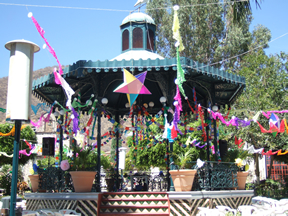 |
|
| Easter in Mexico is like no other place that we have experienced. It is a two-week holiday for school kids and most of the businesses are closed for days at a time. The cities and villages come alive with color and festive events. Here is a partial view of the Plaza in Ajijic. There is a lot of music, parades, fireworks and other festivities where people of all races join in on the celebration. |
On Palm Sunday, the streets are decorated with colorful ribbons. The main (but narrow) streets that lead to the Church were covered with clover. This event was a reenactment of Jesus riding on a donkey into Jerusalem with people cheering him on. (Click to enlarge) |
| |
|
| On Easter Thursday and Good Friday the Church puts on a major performance to reenact the Last Supper, the Trial before Pontius Pilot and the Crucifixion. Here is an elaborate backdrop in the atrium of the Church where Jesus appears before Pontius Pilot. The actors were dressed in the customs of the time. The big statues on stage are "real" people painted with gold paint and they did not move once during the entire performance. The actor playing the role of Jesus was lead into the atrium with his hands bound. Later he was stripped of his garments and brutally tortured to the point that they drew blood. After he was crowned with thorns, Pontius Pilot washed his hands of the entire spectacle and Jesus was lead off to be killed. |
The procession from the Church to the site of the Crucifixion was about two miles. Here the actors carried out the 14 stations of the Cross. We walked up to the foothills of the mountain in upper Ajijic that was to represent Mount Golgotha just in time to see Jesus and the other two criminals carry their crosses up the hill. From where we stood, the reenactment seemed so real, it looked like the actor was being nailed to the cross. Thousands of Mexicans and other visitors like us stood on the street below and watched with amazement how this scene unfolded. Here Jesus "gives up the ghost." From here he was taken off the cross and carried back down to the Church for a reenactment of the burial. |
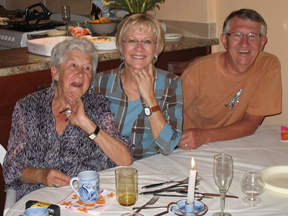 |
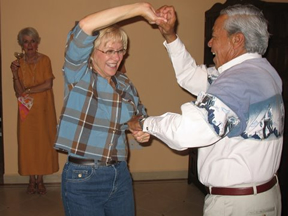 |
| After Easter, Helen, one of our Canadian friends, invited us to a small going away party. She is leaving Ajijic the same day we are. She is one of the sweetest and most graceful women we met during our stay here. |
Helen invited her "private Salsa instructor" to the party who taught several of us some new Latin dance steps. Here it is Glorine's turn and as usual she did a great job keeping up with the instructor. |
| |
|
| Another traditional social/happy hour occurs every Friday night at one of the local restaurants. Between 15 to 30 people show up and after a drink or two, we either stay for dinner or go to another restaurant for dinner and dancing. Here is a group that showed up last Friday. They are a wonderful group and always fun to play with. We had to catch a picture with one of our favorite waiters. We will miss them all. |
Happy Birthday to Glorine. For the first time in 40 years, I was able to pull off a surprise birthday party for Glorine. She turned the BIG "6-0" on Easter Sunday. On Saturday evening, 17 people were at the La Bodega de Ajijic restaurant to join in on the surprise party. Pictured with the birthday girl and Larry are friends Norm and Kathy in the background, our landlords--Ken and Lisa and friends Chuck and Jeanne. Glorine was serenaded by an all-string trio. |
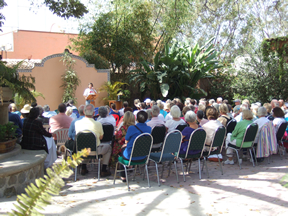 |
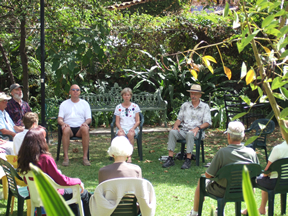 |
| After Mass on Sunday mornings we attend an event put on at the Lake Chapala Society called "Open Circle." Every week they offer a different topic that range from "renewable energy" to "the spirit of sound." We have gone nearly every Sunday since we arrived in December and have found every topic interesting, albeit sometimes provocative. |
Every Monday morning, Larry attends a meditation session sponsored by the Lake Chapala Society. Todd Miller (the guy in the straw hat) is the moderator. A lot of the session centers on the connection of body, mind and spirit and most end with about 15 minutes of silent meditation. After 37 years of working and never having the opportunity to mind rest, it is great to learn about techniques to "quiet the mind." |
 |
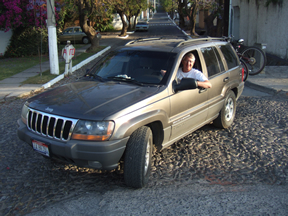 |
| The night before we left Ajijic, we attended a final going away get together with some of those snow birds that have not yet gone north. |
Hey, it all fits! With the Jeep filled to the gills, we begin our journey back home. |
